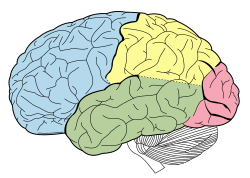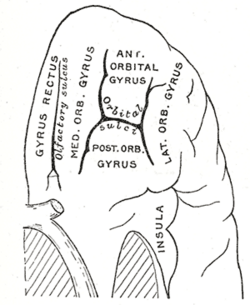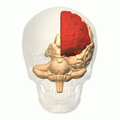Frontal lobe facts for kids
| Brain: Frontal lobe | ||
|---|---|---|
Quick facts for kids
|
||
| Principal fissures and lobes of the cerebrum viewed laterally. (Frontal lobe is shown in pale green.) | ||
| Latin | Lobus Frontalis | |
| Part of | Cerebrum | |
| Artery | Anterior cerebral Middle cerebral |
|
| Acronym(s) | FL | |
The frontal lobe is a very important part of your brain. It's found at the front of each half of your cerebrum. Think of it like the control center for many of your actions.
This part of the brain is located in front of the parietal lobe. It is also above and in front of the temporal lobes.
The frontal lobe helps you decide what to do based on what you see, hear, and touch. It works with the pre-frontal cortex to balance your basic needs, like hunger, with what's socially acceptable. This means it helps you act in a way that fits in with others.
At the back of the frontal lobe is an area called the precentral gyrus. This area contains the primary motor cortex. It controls all your voluntary movements, like moving your arms or legs.
How the Frontal Lobe Evolved
For a long time, many scientists believed that the frontal lobe was much bigger in humans than in other primates. They thought this was a key reason why human cognition (our way of thinking) is different from other primates.
However, newer research has changed this idea. Scientists used Magnetic resonance imaging (MRI) to measure the size of the frontal cortex. They looked at humans, all living ape species, and several monkey species.
What they found was interesting: The human frontal cortex is not much bigger than the cortex in other great apes. But it is relatively larger than the frontal cortex in lesser apes and monkeys. This means our frontal lobe isn't as unique as once thought, compared to our closest relatives.
Images for kids
See also
 In Spanish: Lóbulo frontal para niños
In Spanish: Lóbulo frontal para niños




